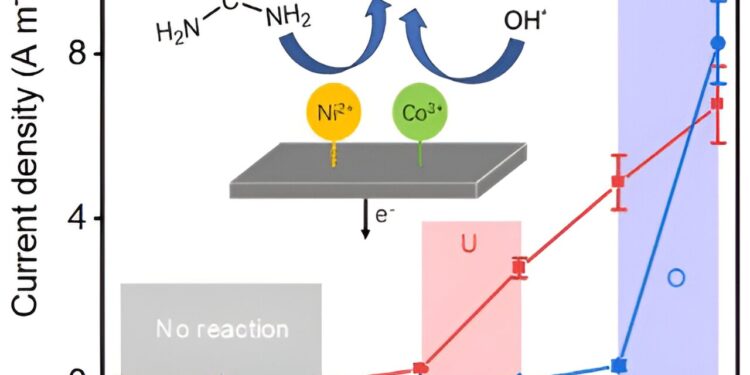Abstract. Exploration of reactive and selective Ni-based electrocatalysts for urea oxidation reaction (UOR) is crucial for the development of urea-related energy conversion technologies. Here, synergistic interactions in Ni/Co mixed oxides/hydroxides enhanced UOR with low onset potential, fast reaction kinetics, and good selectivity against oxygen evolution reaction (OER). Our electrochemical measurements and theoretical calculations signified the collaborative interaction of Ni/Co mixed oxide/hydroxide heterostructures to enhance UOR activity. Our results showed that Ni3+ species, formed at high anodic potential, produced high anodic current mainly from unwanted RELs. Instead, Ni-dominant Ni/Co heterostructures2+ and co3+ the species remained stable at low anodic potential and exhibited an anodic current exclusively attributed to UOR. This work highlights the importance of tuning valence charges for the design of efficient and selective UOR electrocatalysts to benefit from environmental remediation of urea runoff and enable urea electrolysis for production. hydrogen by replacing conventional RELs with UORs at the anode. Credit: The Journal of Physical Chemistry Letters (2023). DOI: 10.1021/acs.jpclett.3c03257
WPI researchers have developed a material to remove urea from water and potentially convert it into hydrogen gas. By constructing these materials made of nickel and cobalt atoms with carefully matched electronic structures, the group unlocked the potential for these transition metal oxides and hydroxides to selectively oxidize urea in an electrochemical reaction.
The study, led by Xiaowei Teng, the James H. Manning Professor of Chemical Engineering at WPI, was published in the Physical Chemistry Letter Journal and highlighted in the publication’s supplemental cover.
The Challenge of Removing Urea from Water
Urea is an inexpensive nitrogen agricultural fertilizer and a natural product of human metabolism. Urea-rich agricultural runoff and municipal wastewater discharges cause eutrophication – harmful algal blooms and hypoxic dead zones that negatively impact the aquatic environment and human health.
At the same time, urea’s unique characteristics make it a potential means of hydrogen storage that could offer viable on-demand hydrogen production. For example, urea is non-toxic, has high water solubility and high hydrogen content (6.7 wt%). Thus, urea electrolysis for hydrogen production is more energy efficient and economical than water electrolysis.
The weakness of urea electrolysis has always been the lack of inexpensive, highly efficient electrocatalysts that selectively oxidize urea instead of water, but Teng and his team found a solution: making electrocatalysts made of nickel and cobalt atoms interacting synergistically with unique electronic structures. for the selective electrooxidation of urea.
Benefit from improved selectivity and activity
The WPI team’s study focused on homogeneous oxides and hydroxides of nickel and cobalt. The researchers found that the key to improving its electrochemical activity and selectivity for urea oxidation lay in tailoring the unique Ni-dominant electronic structures.2+ and co3+ species.
“This electronic configuration is a key factor in improving the selectivity of urea oxidation because we observe that a higher valence of nickel, such as Ni3+, in fact contributes to producing a rapid reaction with a strong production of electric current; however, much of the current came from unwanted oxidation of water,” Teng said.
To better understand this effect, Teng’s group collaborated with Aaron Deskins, a professor of chemical engineering at WPI. Deskins performed the computer simulations and found that the homogeneous mixture of nickel and cobalt oxides and hydroxides benefited from the electronic redistribution of Ni.2+ co3+ species and shifting the valence electrons to higher energy so that the Ni/Co catalysts are better prepared to participate in bonding with urea and water molecules.
Applications and future prospects
Urea, a nitrogen fertilizer and major food additive, was produced commercially as early as the 1920s; approximately 180 million tonnes were produced in 2021. Urea can be derived from natural sources; An adult human produces 1.5 L of urine per day, which is equivalent to 11 kg of urea and 0.77 kg of hydrogen gas per year.
The team’s findings could help use urea in waste streams to efficiently produce hydrogen through the process of electrolysis, and could be used to sequester urea from water, thereby maintaining sustainability long-term ecological systems and revolutionizing the link between water and energy.
More information:
Tongxin Zhou et al, Enhanced electrocatalytic activity of urea oxidation by synergistic mixed oxides of cobalt and nickel, The Journal of Physical Chemistry Letters (2023). DOI: 10.1021/acs.jpclett.3c03257
Provided by Worcester Polytechnic Institute
Quote: New material opens possibility of converting water pollutants into hydrogen gas (January 18, 2024) retrieved January 19, 2024 from
This document is subject to copyright. Apart from fair use for private study or research purposes, no part may be reproduced without written permission. The content is provided for information only.



